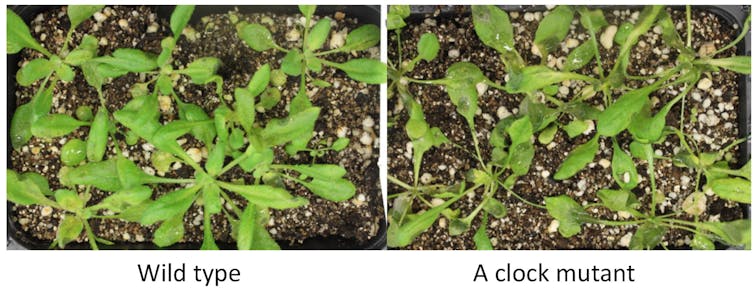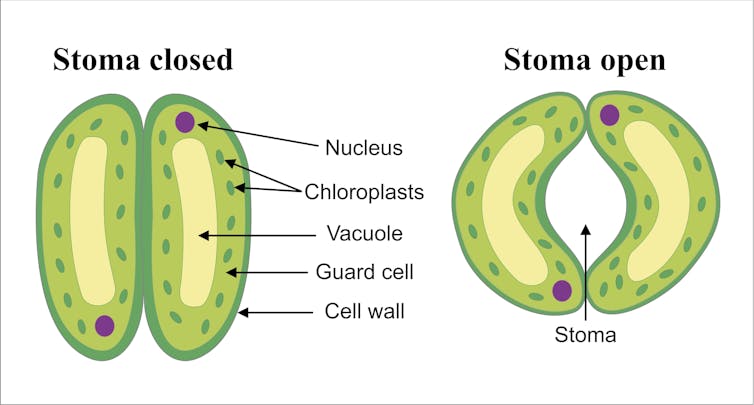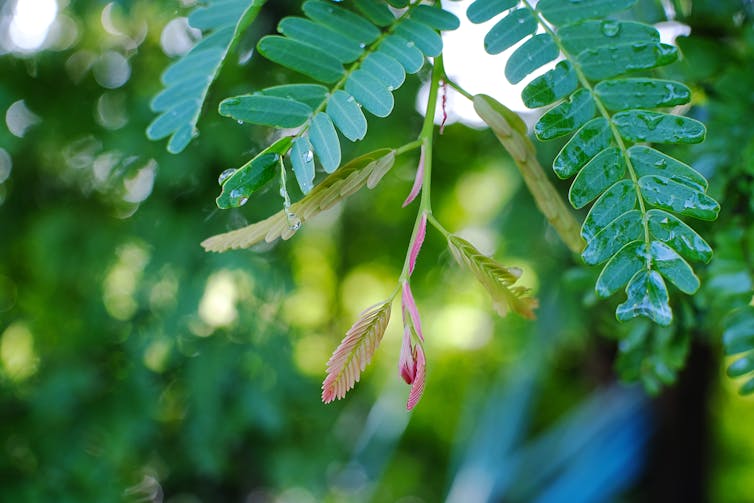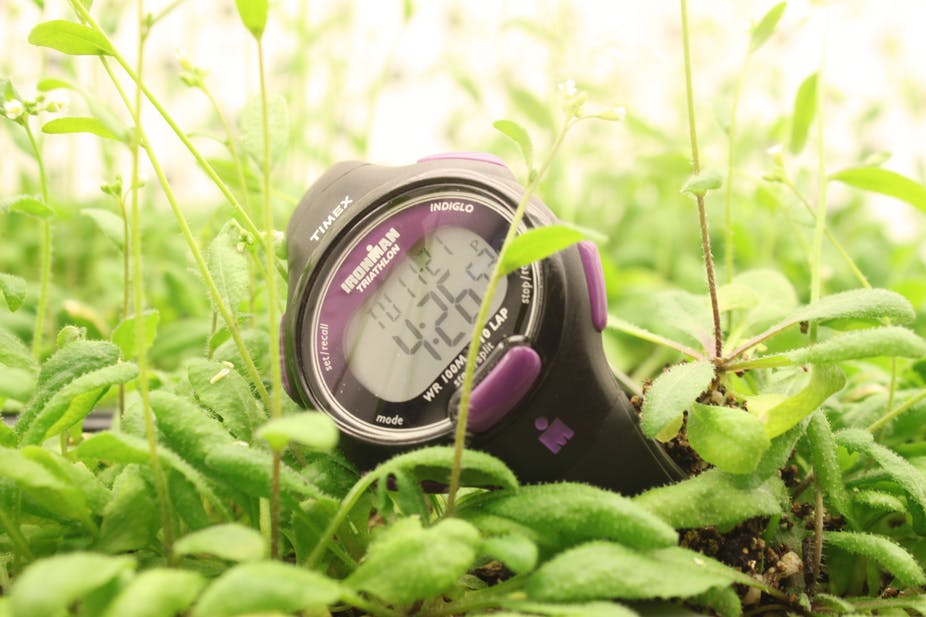Hua Lu, Associate Professor of Biological Sciences, UMBC, and Linda Wiratan, B.S. Student of Biochemistry and Molecular Biology, UMBC
Above photo: CC BY-ND
At dusk, the leaves of the tamarind tree close, waiting for another dawn. Androsthenes, a ship captain serving under Alexander the Great, made the first written account of these leaf movements in the fourth century B.C.
It took centuries longer to discover that he was describing the effects of the circadian clock. This internal time-sensing mechanism allows many living organisms to keep track of time and coordinate their behaviors along 24-hour cycles. It follows the regular day/night and seasonal cycles of Earth’s daily rotation. Circadian research has advanced so far that the 2017 Nobel Prize in physiology or medicine was awarded for the groundbreaking work that elucidated the molecular basis underlying circadian rhythms.
Biologists like us are studying the circadian clocks in plants for insights into how they affect the health and well-being of all life on Earth. As researchers continue to untangle more about how these clocks work – including how they influence interactions between hosts and their invading pathogens and pests – new forms of specially timed precision medicine could be on the horizon.
Our hidden pacemaker
Organisms from all three domains of life possess an amazing diversity of circadian rhythms. Seemingly simple Cyanobacteria alternate photosynthetic activity between day and night. The fungus Neurospora crassa produces spores every morning just before dawn. Migratory monarch butterflies use a delicate sun compass in their annual migration. Almost every aspect of human activity is influenced by the circadian clock – you can easily see this in yourself if you fly across time zones or engage in shift work.
The driving force behind circadian rhythms is what scientists call the circadian clock’s central oscillator, an elaborate network of genes that turn each other’s activity on and off. Together, they form complex feedback loops that accurately calibrate time.
Although individual clock genes are not always the same across domains of life, the feedback mechanism of the central oscillator is. This mechanism acts as a switch to synchronize an organism’s daily activities with day and night fluctuations and other environmental changes. Such amazing balancing acts reflect organisms’ abilities to anticipate changing environment throughout the day.
Precise timekeeping and health
A well-calibrated circadian clock is critical for growth and fitness, which is why misalignment of the circadian clock with environmental cues causes diverse and far-reaching health issues. Some human diseases, including diabetes, obesity, cardiovascular disease and some psychiatric disorders such as depression and bipolar disorder, are likely linked to circadian clocks being out of sync with the environment.

Hua Lu, CC BY-ND
Increasing evidence also links the circadian clock to plant health. In particular, plant scientists have shown that a properly tuned circadian clock is important for plant disease resistance to arrays of pathogens and pests. Although plants do not produce antibodies or use specialized immune cells to ward off invaders, some aspects of their immune system are similar to ours. Because of how easy it is to grow and genetically manipulate them, some plants, like Arabidopsis, serve as ideal systems to investigate how the circadian clock influences the outcome of diseases in plants once infected.
Plant-pathogen interactions around the clock
Plants, being immobile, must strategically allocate their limited energy and resources when faced with pathogens and pests. They have the sophisticated ability to time their defense, which allows them to anticipate likely attacks before they occur and modulate defense responses to real attackers.

Valentina Moraru/Shutterstock.com
The forefront of plant defense is on the surface. Physical features like trichomes, little hairs that stick out, protectively cover a plant, and wax coatings deter invaders from clinging onto the surface. The plant surface also has numerous mouth-like pores called stomata. Normally, stomata rhythmically open in the day and close at night, a process regulated by the circadian clock in anticipation of light and humidity changes. While this process is important for photosynthesis and water exchange, opening stomata can be used by some pathogens as portals to access nutrients and space inside the plant tissue and closing stomata restrict pathogen invasion.
Beyond frontline physical barriers, plants have evolved complex surveillance systems to detect pathogens and pests as intruders. When cell surface receptors recognize a pathogen, the plant immediately closes its stomata at the invasion site. Dysfunctional circadian clocks impair stomatal closure, resulting in more severe disease.
Further pathogen recognition sends alert signals deep into the plant tissue, activating an arsenal of defense responses, including reprogramming of gene expression, production of antimicrobial compounds and enhancement of defense signaling. Even in the absence of pathogens, many of these responses show low but rhythmic changes that are influenced by the circadian clock. When a real attack arrives, the plants’ daily rehearsal of their defense systems ensures a strong and concerted timely defense. Plants with misaligned clocks succumb to the attack.
One excellent example of a plant timing its defense comes from Xinnian Dong’s group at Duke University. Hyaloperonospora arabidopsidis is a pathogen that disseminates its virulent spores in the morning and causes disease in Arabidopsis plants. Dong’s group elegantly showed that Arabidopsis anticipates this attack by expressing a set of defense genes at dawn that gives resistance against the pathogen. When the researchers disrupted the Arabidopsis circadian clock, it abolished this morning defense and made the plant more susceptible.
Plants also rely on timely defense to fight off insects. For instance, cabbage loopers have peak feeding activity before dusk. Beautiful work by Janet Braam’s group at Rice University showed that Arabidopsis produces the defense signaling hormone jasmonic acid with a peak at noon in anticipation of this attack. When the insects actually strike, the circadian clock boosts this noon defense, producing more jasmonic acid to inhibit insect feeding.
Do clocks dance in pairs?
As seen from these examples, pathogens and pests have their own circadian clocks and use them to determine the best time to be active. How does this ability affect their invasions of hosts? So far, researchers aren’t sure whether pathogen and pest clocks are coordinated to that of the host. If they are, their how in sync they are could determine the outcome of their interactions.
Current evidence indicates that some eukaryotic microbes, such as Hyaloperonospora arabidopsidis and Botrytis cinerea, are able to manipulate the Arabidopsis circadian clock. Even prokaryotic pathogens, like Pseudomonas syringae, in spite of lacking a canonical central oscillator, can interfere with plant clocks in various ways.
In humans and mice, some populations of gut microbiota oscillate daily, depending on the host circadian clock. Interestingly, gut microbiota are capable of reprogramning the host clock. How does this transkingdom communication occur? How can it influence the outcome of host and microbe interactions? Research in this area represents a fascinating and unexplored level of host-invader dynamics.

oraphan_nan/Shutterstock.com
The clock as healer and helper
The ability to integrate time cues with development and responses to environmental assaults is an evolutionary adaptation. Plants have taught biologists much about circadian rhythms and their role in modulating everything from development to defense.
Clock research has opened an opportunity to apply this knowledge to other systems, including humans. How can we modify the daily cycling of certain defense features to enhance immunity without causing developmental stress? What times of day are we most susceptible to certain pathogens? What are the most invasive times of day for various pathogens and pests?
Answers to questions like these will help unravel host-pathogen/pest interactions, not just in plants but also in people. Ultimately, this knowledge could contribute to the design of precision medicines that are tailored to boost timely defense in individual people to fight against various pathogens and pests. In addition, our understanding of plant disease resistance will aid agricultural control of pathogens and pests, mitigating the global challenge of crop loss.
![]() Ongoing research continues to reveal how the influence of circadian rhythms extends as boundlessly as the sun’s rays.
Ongoing research continues to reveal how the influence of circadian rhythms extends as boundlessly as the sun’s rays.
Hua Lu, Associate Professor of Biological Sciences, University of Maryland, Baltimore County and Linda Wiratan, B.S. Student of Biochemistry and Molecular Biology, University of Maryland, Baltimore County
This article was originally published on The Conversation. Read the original article.
Tags: The Conversation

